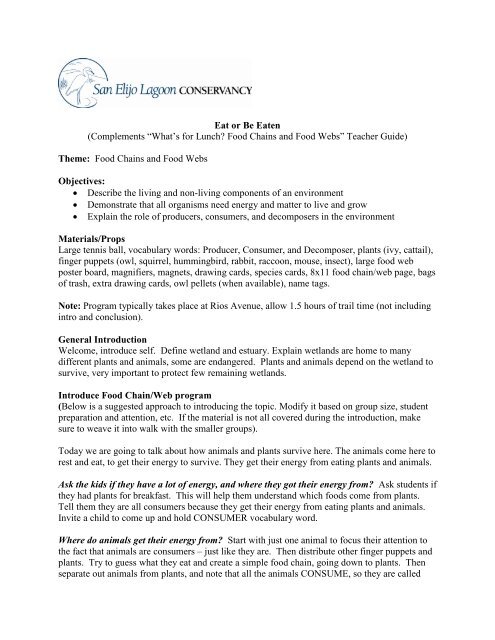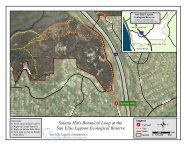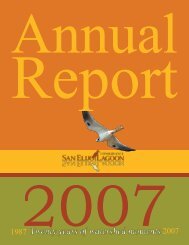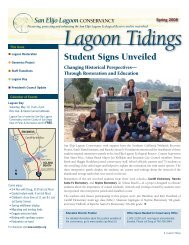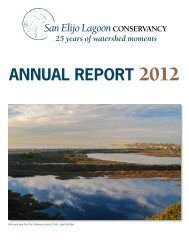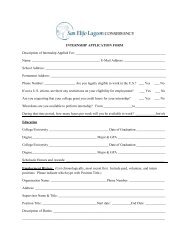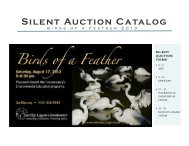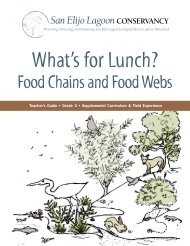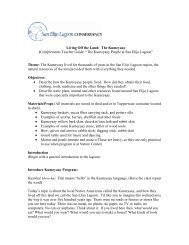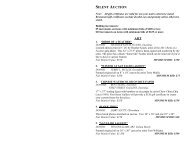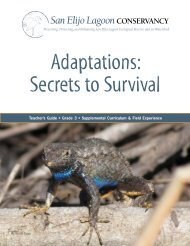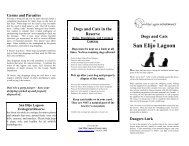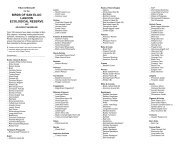Food Chains
Food Chains
Food Chains
Create successful ePaper yourself
Turn your PDF publications into a flip-book with our unique Google optimized e-Paper software.
Eat or Be Eaten<br />
(Complements “What’s for Lunch? <strong>Food</strong> <strong>Chains</strong> and <strong>Food</strong> Webs” Teacher Guide)<br />
Theme: <strong>Food</strong> <strong>Chains</strong> and <strong>Food</strong> Webs<br />
Objectives:<br />
Describe the living and non-living components of an environment<br />
Demonstrate that all organisms need energy and matter to live and grow<br />
Explain the role of producers, consumers, and decomposers in the environment<br />
Materials/Props<br />
Large tennis ball, vocabulary words: Producer, Consumer, and Decomposer, plants (ivy, cattail),<br />
finger puppets (owl, squirrel, hummingbird, rabbit, raccoon, mouse, insect), large food web<br />
poster board, magnifiers, magnets, drawing cards, species cards, 8x11 food chain/web page, bags<br />
of trash, extra drawing cards, owl pellets (when available), name tags.<br />
Note: Program typically takes place at Rios Avenue, allow 1.5 hours of trail time (not including<br />
intro and conclusion).<br />
General Introduction<br />
Welcome, introduce self. Define wetland and estuary. Explain wetlands are home to many<br />
different plants and animals, some are endangered. Plants and animals depend on the wetland to<br />
survive, very important to protect few remaining wetlands.<br />
Introduce <strong>Food</strong> Chain/Web program<br />
(Below is a suggested approach to introducing the topic. Modify it based on group size, student<br />
preparation and attention, etc. If the material is not all covered during the introduction, make<br />
sure to weave it into walk with the smaller groups).<br />
Today we are going to talk about how animals and plants survive here. The animals come here to<br />
rest and eat, to get their energy to survive. They get their energy from eating plants and animals.<br />
Ask the kids if they have a lot of energy, and where they got their energy from? Ask students if<br />
they had plants for breakfast. This will help them understand which foods come from plants.<br />
Tell them they are all consumers because they get their energy from eating plants and animals.<br />
Invite a child to come up and hold CONSUMER vocabulary word.<br />
Where do animals get their energy from? Start with just one animal to focus their attention to<br />
the fact that animals are consumers – just like they are. Then distribute other finger puppets and<br />
plants. Try to guess what they eat and create a simple food chain, going down to plants. Then<br />
separate out animals from plants, and note that all the animals CONSUME, so they are called
CONSUMERS (point to vocabulary word). Highlight “insect” and note that it is a consumer and<br />
a decomposer (bring out decomposer vocab word), and ask students if they can tell you what is<br />
unique about a decomposer. Thank “animal” volunteers and ask “plant” volunteers to stay.<br />
Where to plants get their energy from? The Sun! (ask a student to hold the sun). The sun is the<br />
most important object in our universe. Without it plants and animals would not be able to<br />
survive. Almost all life on earth depends on the sun for its energy.<br />
Because plants make or produce their own food, there is a special word we use to describe<br />
plants, and it starts with a P, can anyone tell me what that word is? PRODUCERS. Plants are<br />
producers because they use energy from sunlight to produce their own food, they are not<br />
CONSUMERS. To help you remember that plants are Producers, think of 2 P’s, P for Plant and<br />
P for Producer. Ask a student to hold the PRODUCER card. Review vocabulary words<br />
Consumers, Decomposers, and Producers.<br />
Walk Preparation<br />
Prepare students for a walk, divide into smaller groups – go over trail rules.<br />
General discussion points while hiking<br />
All organisms need energy to survive. The ultimate source of energy is the sun.<br />
All life depends upon living (biotic) and non-living (abiotic) things.<br />
Living organisms depend on one another and on their environment for survival.<br />
In an ecosystem, energy flows from the sun to producers (plants), to consumers<br />
(animals), and ending with decomposers.<br />
Plants are primary producers because they produce their own food.<br />
Consumers must depend on plants or other consumers to get the energy they need.<br />
A food chain shows transfer of food from one living thing to another.<br />
Breaks in a food chain affect life in both directions from the break.<br />
A food web is many interconnected food chains.<br />
At each link in the food chain, some of the food energy is used, therefore less energy is<br />
available for consumers who are further from the producers in the food chain (this may<br />
be a hard concept to grasp, read the group before introducing).<br />
Everything in nature is recycled and reused.<br />
Specific examples to discuss along the trail<br />
As you come across different animals (insects, lizards, birds) discuss what they might eat,<br />
and what might eat them. If appropriate, introduce vocabulary words herbivores,<br />
carnivores, and omnivores.<br />
<br />
<br />
You are likely to see lizards, what is their role in ecosystem? <strong>Food</strong> for birds, bats,<br />
raccoons, and snakes. – discuss what would happen if all the lizards were wiped out,<br />
how would that affect the food chain?<br />
What role do insects play? <strong>Food</strong> source for many birds, bats, and spiders. Many plants<br />
rely on insects for pollination. Make sure students know the term, pollination.<br />
2
.<br />
<br />
<br />
What happens to animals that die in nature? Are they buried, put into the trash? No,<br />
nature is able to recycle them. Crows, ravens, insects, flies, fungi, bacteria. They all<br />
have a role in helping to break down the animal and return it back to the soil as nutrients.<br />
These nutrients enrich the soil and allow more plants to grow.<br />
Compare pickleweed, riparian, and sagebrush plant communities. Why are they so<br />
different? Because the non-living components found in these habitats are different.<br />
How? Salt water, freshwater, water-logged soil vs. dry soil. These non-living<br />
components determine what plant communities can survive there, which determines the<br />
types of plants, insects, reptiles, and mammals that will be able to survive there.<br />
Activities to incorporate in the Field<br />
1) Exploring Soils. Use magnets to observe soil and see if you can pull out magnetite (iron). By<br />
doing this, you will see that soils are a mix of many things, both organic and inorganic. Ways to<br />
introduce this topic might be: just like us, plants need many nutrients to grow and survive. For<br />
example, iron is an important nutrient in humans, and plants need it as well. They are able to<br />
pull it out of the soil, and when we eat plants or other animals, we get the iron we need to<br />
survive. Let’s see if we can find some iron in this soil. Very simplified version: “soils are made<br />
up of many different materials that plants use to grow…let’s see what we can find.”<br />
2) <strong>Food</strong> web laminated page – Sit for a moment to review the difference between a food<br />
chain and food web, using the laminated page from Teacher Guide. Try to explain the<br />
energy flow, and who is getting energy from where, and how a break in the food chain<br />
can affect the entire ecosystem. An ecosystem is made up of all the living and nonliving<br />
things that interact in an area. Students can point to living and non-living things in<br />
diagram. Might be a good time to introduce words omnivore, carnivore, herbivore, and<br />
decomposers.<br />
3) Exploring soil, plants, and insects: – Use magnifying lenses to get a closer look at the<br />
soil, see salt crystals on saltgrass, observe insects. Do not let the kids hold on to the<br />
magnifying glasses for an extended period of time. Take them out for the activity, then<br />
collect them and put them away.<br />
3
4) Decomposers and recycling - Discuss how things in nature are recycled naturally,<br />
compared to how some man-made things, such as plastic do not break down naturally.<br />
It is important that we recycle plastic, but it is even more important that we try to limit<br />
the amount of plastic we use because plastic NEVER breaks down. Why is that bad?<br />
Animals mistake plastic for food, causing them to choke, or mistakenly think they are<br />
full. A straw might look like a worm, a plastic bag like a jelly fish, a bottle cap like a<br />
shellfish. FBI - Fungus, Bacteria, and Insects – Nature’s decomposers.<br />
Optional Activities<br />
5) Species Cards – Allow students to pick card, guess what that animal might eat or who<br />
eats it. These will also allow for discussion of food chains and webs, as well as a means<br />
to reinforce vocabulary words herbivore, carnivore, and omnivore. Can be paired with<br />
following sketching activity.<br />
6) Sketching – Find a quiet place to sit. Ask students to sketch a P, C, or D on an index<br />
card. For Habitat we are looking for wetland, riparian, sage scrub, or a combination. If<br />
students seem interested, have some of them share what they drew and how it is labeled.<br />
Do not spend more than 10 minutes on this activity. When done collect cards and<br />
pencils. We will want to give all the cards to the teachers so they can recreate a food<br />
web in the classroom.<br />
7) Owl Pellets – Carry your own in a bug box, or coordinate with other docents to plant<br />
one along the trail in advance.<br />
Wrap Up<br />
Living organisms all have the same basic needs and depend on non-living things for survival<br />
(energy, nutrients, air, shelter, and water). Moving, growing, and eating all require a source of<br />
energy.<br />
Where do plants get their energy from? Where do animals get their energy from?<br />
Did anyone see a producer, or a consumer? Let kids share what they saw and for the producers,<br />
ask if they know what it eats and if it is a omnivore, carnivore, or herbivore?<br />
Why are decomposers (FBI) important?<br />
Did anyone see anything that didn’t belong in nature?<br />
4
Animal/Plant Energy Sources<br />
Species Eats Eaten or destroyed by<br />
Algae Photosynthesis CA Horn Snail, Fiddler<br />
Crab<br />
Picklweed Photosynthesis Belding’s Savannah<br />
Sparrow<br />
Fiddler Crab Algae, dead animals Clapper rail<br />
Clapper Rail<br />
Crabs, snails, worms, Coyote, raccoon, hawks<br />
aquatic insects<br />
Black phoebe Insects Cooper’s Hawk, Sharp<br />
shinned hawk<br />
CA Horn Snail Algae Very hard shell – difficult<br />
to eat<br />
Mallard<br />
Aquatic vegetation and<br />
invertebrates<br />
Raccoons, opossum,<br />
peregrine falcon<br />
Topsmelt Algae Great Blue Heron<br />
Fence lizard insects King snakes, striped racers,<br />
Alligator lizard, hawks,<br />
raccoons<br />
Mullet Plankton, invertebrates Sea Lions, Osprey<br />
CA Killifish<br />
Insects, worms, larvae of<br />
other fish<br />
Great Blue Heron, Snowy<br />
Egret<br />
Osprey Mullet Great horned owl (nestlings,<br />
occasionally adults)<br />
Red Tailed Hawk<br />
Small rodents, rabbits,<br />
snakes, lizards<br />
Humans through pollution<br />
and habitat destruction<br />
Raccoon<br />
Fish, crabs, rodents, birds,<br />
bird eggs, plant material,<br />
Bobcats, Mountain Lions,<br />
coyotes, humans<br />
your garbage<br />
Coyote Mice, rats, insects, rabbits Humans, cars<br />
(Note: For Content Standards for CA Public Schools, Vocabulary list, and food web diagram see<br />
coinciding Teacher Guide: What’s for Lunch? <strong>Food</strong> <strong>Chains</strong> and <strong>Food</strong> Webs)<br />
Developed for SELC Docent Training 2009, revised 2012<br />
5


